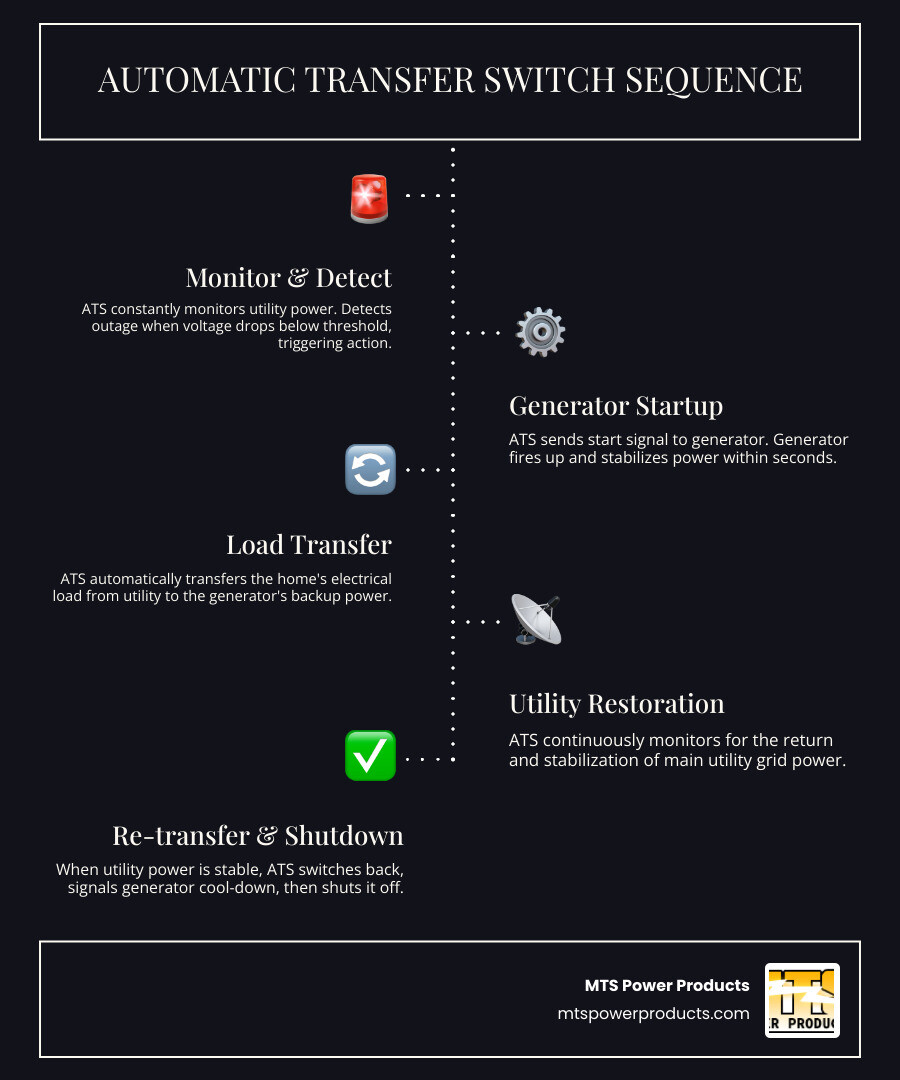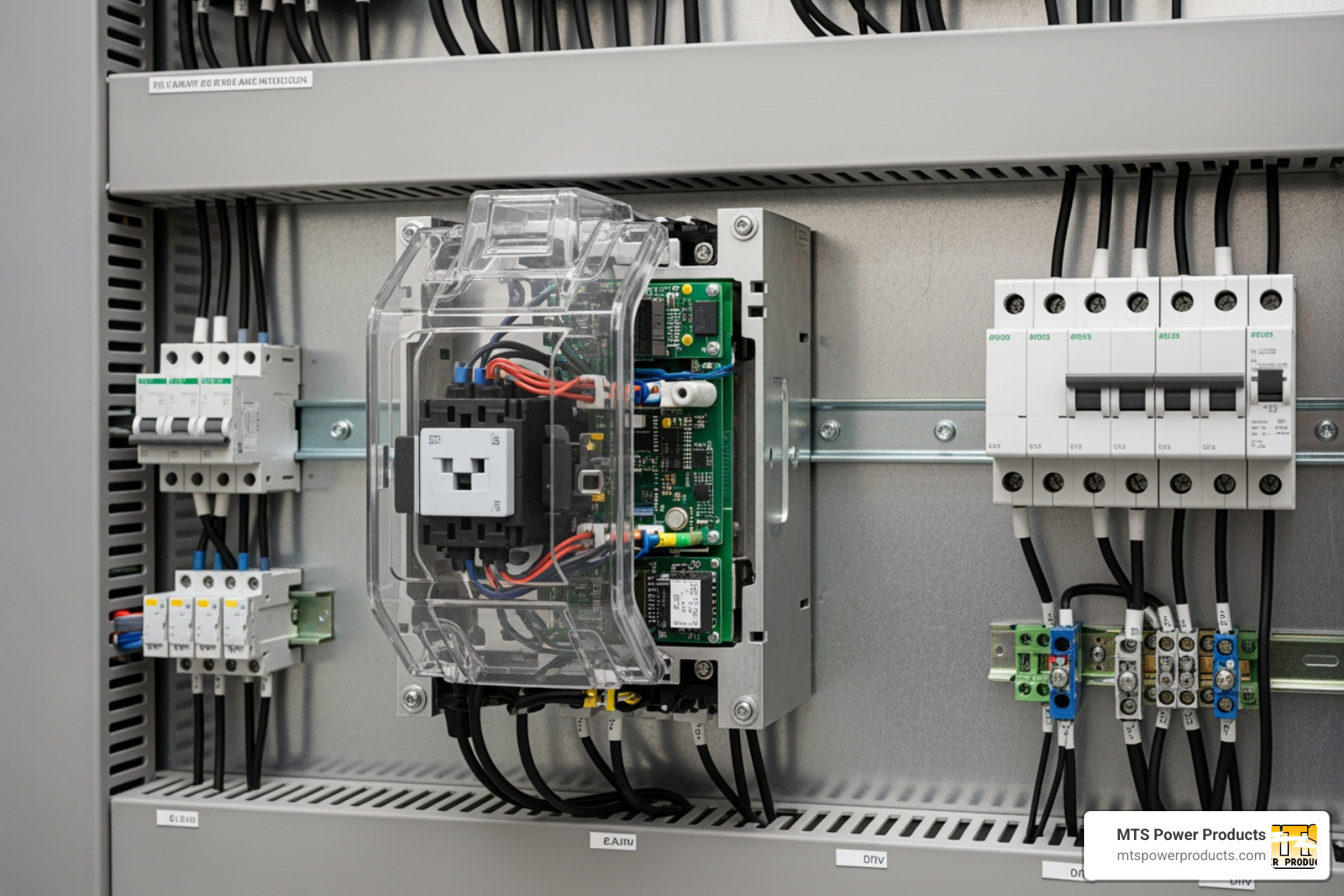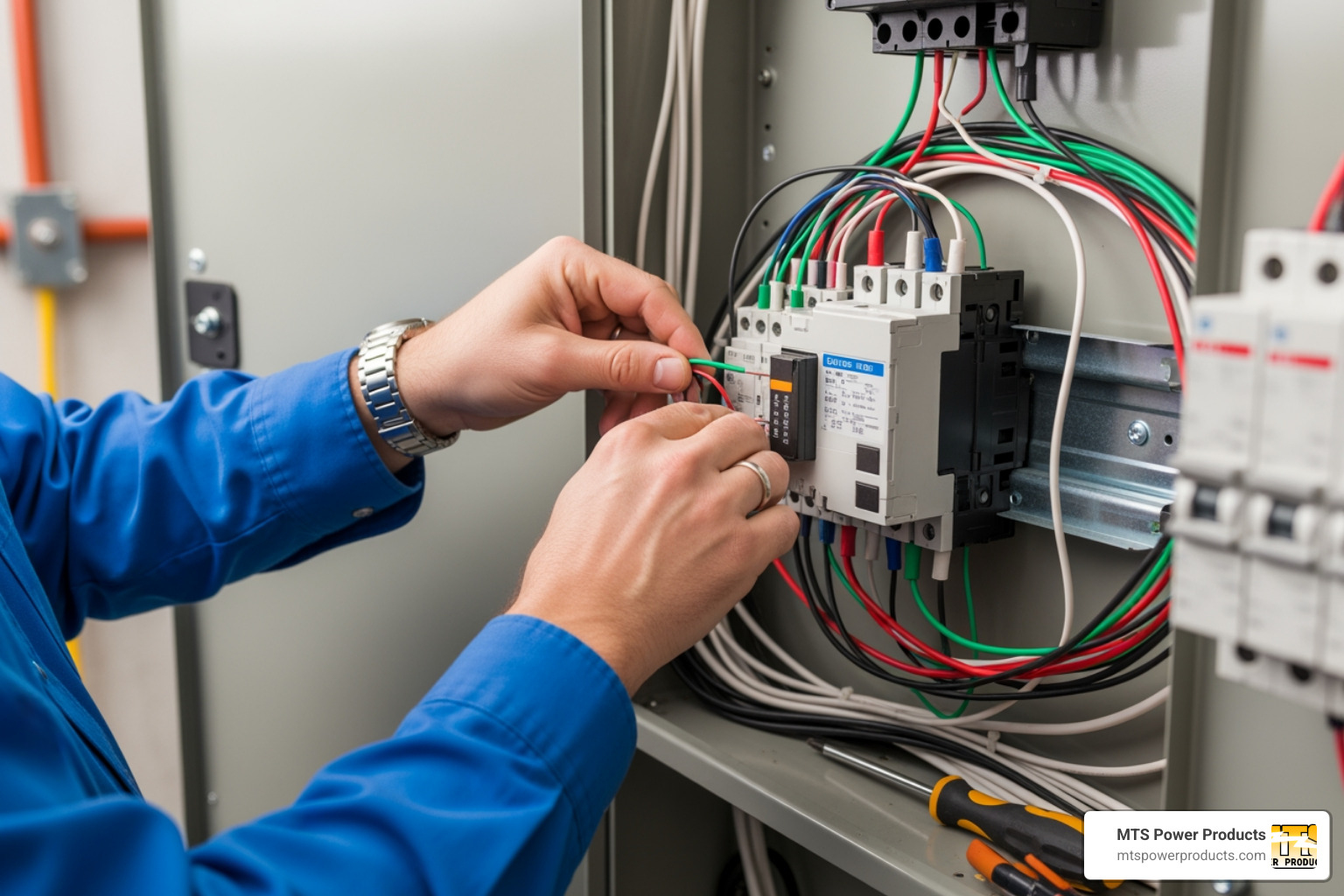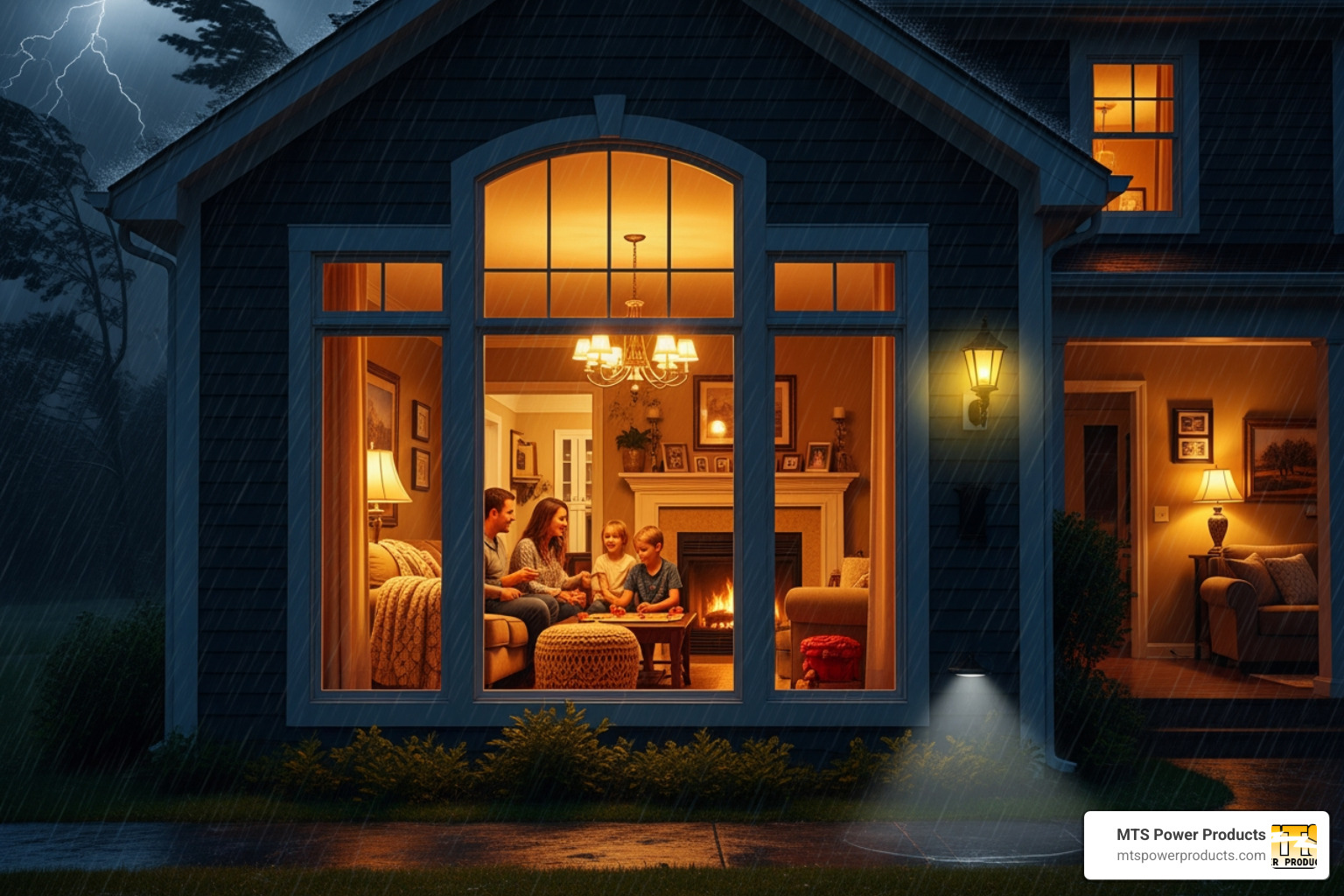Buy Direct
from the Manufacturer
Sell our Products
Become a Distributor
Discounts
on volume purchases
Visit Us
at our Miami office
from the Manufacturer
Become a Distributor
on volume purchases
at our Miami office
Generators with automatic transfer switches provide the ultimate solution for seamless backup power during outages. If you’re looking to buy a complete system, here’s what you need to know:
Quick Answer: What You’re Looking For
Why This Matters
When the power goes out, you face more than just darkness. For homeowners, an outage can mean spoiled food, no air conditioning during a sweltering Florida summer, and disabled security systems. For a business, even a few minutes of downtime can halt production, disrupt operations, and lead to significant financial losses.
An Automatic Transfer Switch (ATS) is the brain that makes your generator truly automatic. It constantly monitors your utility power and, the moment it detects an outage, signals your generator to start. It then automatically transfers your electrical load to the generator, restoring power to your home or facility in about 10 seconds.
Without an ATS, you would need to manually start your generator and use a cumbersome, potentially unsafe manual transfer switch. With an ATS, the entire process is handled for you, whether you’re home, at work, or away. When utility power is restored, the ATS seamlessly switches you back to the grid and shuts down the generator, all without any intervention.

Find more about generators with automatic transfer switches:
When the power goes out, you want the lights back on as quickly and safely as possible. That’s the job of an Automatic Transfer Switch (ATS). It’s the intelligent component in a standby power system that makes the transition from utility power to generator power seamless and automatic. For a neutral overview of how these devices work, see this summary of a transfer switch.
An ATS is the crucial link between your property’s electrical system, the utility grid, and your backup generator. It constantly monitors the incoming utility voltage. The moment it detects a power failure, it automatically starts your generator and transfers the electrical load to it. This entire process typically happens in 10 seconds or less, ensuring you have reliable backup power with minimal interruption. This provides not only convenience but also true peace of mind and safety.
Here’s a simplified look at how an ATS works to restore your power:
An automated backup power system offers significant advantages beyond just keeping the lights on.
Alright, so you’re ready to accept the magic of generators with automatic transfer switches! That’s fantastic. But before you dive in, let’s talk about picking the right ATS for your specific needs. It’s a bit like choosing the perfect co-pilot for your generator – you want one that’s perfectly matched to your journey, ensuring smooth sailing no matter the weather. At MTS Power Products, we know that selecting the correct ATS is crucial for top performance, utmost safety, and staying compliant with all electrical codes. It’s definitely not a one-size-fits-all kind of deal, and there are a few important things to think about.
First things first: we need to make sure your ATS is the right fit. This mostly comes down to its amperage rating. Think of it like this: your ATS’s amperage needs to be strong enough to handle all the power your home or business uses, and it also needs to match up with what your generator can put out.
This might sound a bit technical, but it’s a really important distinction, especially for how your ATS gets installed and how it adheres to electrical codes, particularly if you’re looking for whole-house backup.
Choosing the right type isn’t just about functionality; it’s about making sure your system is safe and follows all the rules set by the National Electrical Code (NEC) and local regulations right here in Miami, FL.
Beyond just how big your ATS is, the way it actually switches power and the internal components it uses also vary. These differences can impact how your system performs and what it’s best suited for.
This refers to the tiny moment when your power source changes over. It’s all about how gracefully that switch happens!
| Transition Type | Description
Selecting the perfect ATS for your generators with automatic transfer switches setup is a pivotal decision. It’s not just about getting “a switch”; it’s about getting the right switch that integrates with your generator and electrical needs.
The size of your ATS, primarily its amperage rating, is paramount. This rating must be chosen to match your electrical service and generator capacity.
This affects installation and code compliance.
| Transition Type | Description |
|---|---|
| Open Transition | Break-before-make. Brief, acceptable interruption during transfer. Common for residential and many commercial systems. |
| Closed Transition | Make-before-break. No interruption; requires synchronization. Used in critical facilities; higher complexity and cost. |

When you’re shopping for generators with automatic transfer switches, you’re really looking at a complete backup power solution—not just individual parts. The key is finding a system where the generator and ATS work together seamlessly. At MTS Power Products, we specialize in exactly this kind of integration, offering professional-quality systems including our own McPherson Controls line, designed specifically for superior performance and safety in real-world conditions.
Matching your generator to your ATS is critical for a reliable system. Here are the key factors to consider:
Generator Compatibility: Your ATS must be compatible with your generator’s voltage, phase, and control signals. It’s an essential first step for proper communication and function.
Amperage Matching: Whether you need a 100A system for a smaller home, a 200A setup for a typical family house, or a larger 400A, 600A, or 800A system for a large property or business, your ATS must be rated for your electrical service and your generator’s output.
Single-Phase vs. Three-Phase: Most homes in Miami, FL, use single-phase power, while commercial buildings often require three-phase systems. Your ATS and generator must both be designed for your property’s specific power type.
Fuel Type: Your generator’s fuel source—natural gas, propane, or diesel—affects installation and operating costs. While the ATS doesn’t use fuel, its integration with the generator is part of the overall system design.
Load Management: An ATS with intelligent load management can prioritize essential circuits and shed non-essential ones during an outage. This feature can allow you to use a smaller, more cost-effective generator while still keeping critical systems running.
The market offers a wide range of automatic transfer switches. At MTS Power Products, we’re proud of our McPherson Controls line, which is designed with advanced features like remote monitoring, programmable displays, and robust safety standards to meet professional-grade requirements. Other manufacturers also offer quality solutions, including Generac’s automatic transfer switches, Kohler’s RXT series, and Briggs & Stratton’s Symphony II switches.
Residential (100A-200A): These are typically open-transition switches, often service-entrance rated for whole-home backup. They provide reliable, automatic power for most households. Popular options include models from Generac, Kohler, and our McPherson Controls line.
Mid-Range Commercial (200A-400A): These units often feature more advanced controllers, NEMA 3R enclosures for outdoor use, and may offer closed-transition options for businesses that cannot afford any power interruption. ASCO Power Technologies and Eaton offer competitive solutions in this range alongside our McPherson Controls products.
Heavy-Duty Industrial (400A-800A+): Built for demanding environments, these systems use power frame switching mechanisms to handle massive electrical loads in facilities like hospitals, data centers, and manufacturing plants. Leading manufacturers include ASCO, Eaton, and our professional-grade McPherson Controls systems.
At MTS Power Products, our McPherson Controls line represents our commitment to providing professional-grade solutions customized to meet the exacting demands of our clients in Miami, FL, and worldwide. We engineer complete power solutions that integrate advanced monitoring, programmable controls, and superior safety features. Being centrally located near Miami International Airport and the Port of Miami, we can deliver these custom solutions wherever they are needed.
When it comes to installing generators with automatic transfer switches, this is not a DIY project. An Automatic Transfer Switch (ATS) connects directly to your main electrical service, and improper installation can lead to fire, equipment damage, or severe injury. For the safety of your home, family, and utility workers, professional installation by a licensed and certified electrician is essential and often required by law.

A professional installation ensures your system is safe, reliable, and compliant with all codes. The process generally includes:
Following these steps ensures compliance with the National Electrical Code (NEC) and local regulations. Attempting to bypass professional installation can void warranties and create significant safety hazards.
An ATS is the core of a safe and dependable backup power system. Its design incorporates several key safety features:
With a professionally installed system from MTS Power Products, you are investing in unwavering safety and reliability for your home or business.
We hear a lot of questions from folks in Miami, FL, and beyond about generators with automatic transfer switches. Let’s tackle some of the most common ones to help you feel confident about your backup power decisions.
While it may be tempting to DIY, installing an ATS is a job for a licensed professional. It involves working with high-voltage electricity and requires a deep understanding of the National Electrical Code (NEC) and local regulations. An incorrect installation can lead to serious safety hazards, including electrical shock, fire, and dangerous backfeeding into the utility grid, which can endanger utility workers. It can also damage your equipment and void your warranties. For safety and compliance, always hire a certified electrician.
Choosing the right size ATS is crucial for a reliable system. The size, rated in amps, depends on your electrical needs.
A qualified electrician can perform a load calculation to determine your exact needs and recommend the right ATS and generator combination. At MTS Power Products, we can help you with this assessment to ensure your system is perfectly matched to your requirements.
One of the biggest benefits of an automatic system is the speed of the transfer. In most cases, power is restored in 10 seconds or less.
When a power outage occurs, the ATS senses the loss of utility power and immediately signals the generator to start. Once the generator is running at the correct speed and voltage, the ATS safely disconnects from the utility line and switches your home’s electrical load to the generator. The entire process is so fast that you’ll barely notice the interruption.
Investing in generators with automatic transfer switches is more than just buying equipment; it’s an investment in security, comfort, and peace of mind. For homes and businesses in areas like Miami, FL, where power outages can be frequent, a reliable backup system is essential. An ATS is the key to making that system seamless and automatic, ensuring you have power when you need it most without any manual effort.
From selecting the right size and type to ensuring a safe, code-compliant installation, every step is critical. An ATS protects your property, your sensitive electronics, and the utility workers who keep our grid running.
At MTS Power Products, we are your direct source for professional-grade generators, automatic transfer switches, and our exclusive line of McPherson Controls. We specialize in creating customized, integrated systems that meet the highest standards of safety and performance. Located near the Miami International Airport and the Port of Miami, we are positioned to deliver reliable power solutions anywhere in the world.
Power your home or business with confidence. Let us help you find the perfect automatic transfer switch for your generator.

